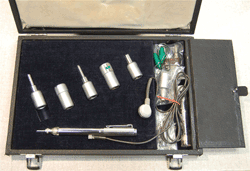What’s It Worth: Signal tracers
BY STEVE JOHNSON
(
)
Since the beginning of radio service shops in the late 1920s, signal tracers have been an integral part of the service tools used for repairing radios, televisions, amplifiers, and other electronic equipment. The ability to follow the signal path to find where a problem exists was a critical part of the repair process. Signal tracers have used several methods to indicate the presence of a signal: an audible sound through a speaker or headphone, a visual indication by meter or eye tube, or by connection directly to an oscilloscope (which in itself is a visual signal tracer). Today the oscilloscope is the most commonly used signal tracer.
Signal tracers for service and circuit design work have been packaged in many forms over the years from large bench equipment with many functions to a shirt pocket tracer the size and shape of a pen.
Most signal tracers used for service work in the 1930s used vacuum tubes and took up considerable bench space. The model 562 Audolyzer manufactured by Supreme Instruments of Greenwood, MS, was one of the first signal tracers designed for bench use. Weighing in at a hefty 28 pounds it could not be considered a portable in spite of the handles affixed to each side of it's case. Early versions were housed in solid oak cases. Later versions were enclosed in metal cases. The Audolyzer was manufactured for several years from around 1938 through 1947. In 1948 a newer version with added features was released under the model number 688.

The Supreme Audolyzer is a bench RF and audio signal tracer, ohm meter, and Vacuum Tube Volt Meter (VTVM) in a single unit.
The Audolyzer was a combination radio frequency and audio generator, signal tracer, ohm meter, and Vacuum Tube Voltmeter (VTVM). It gave the serviceman most of the equipment needed in one package to perform troubleshooting on consumer radios and public address systems. The radio frequency generator section could be modulated and used as a low power AM radio transmitter although it would probably not be legal to use by today's FCC regulations. Two test probes were provided, one for radio frequencies and the second for audio work.
If you are patient, early versions of the Audolyzer in good condition in it's original oak case may be found in the $80-$150 range. This does not usually include packing and shipping charges which can be costly due to the weight and size of the instrument.
Another popular all-in-one bench analyzer that included a signal tracer “The Rider Chanalyst”, was released just after the Audolyzer. The Chanalyst, was discused in detail in a previous article ( http://www2.electronicproducts.com/What_It_s_Worth_The_Rider_Chanalyst-article-fasj_worth_oct2011-html.aspx).
During the 1950s many service grade signal tracers were manufactured. Two of the most common that are still in use today on hobbyists and collectors benches were sold as kits. The small Heathkit IT-12 and the EICO 147A signal tracers are both simple audio amplifiers with probes. They both give an audible indication by speaker or visually with an eye tube. These can be found at swap meets for $15-$35 depending on condition. Some are stripped of their eye tube when found as eye tubes have increased in value over the past few years. A replacement eye tube for a signal tracer may cost as much as the signal tracer itself.

The Stethotracer was a pen-sized signal tracer.
One of the most unique signal tracers appeared in the shirt pockets of engineers in the early 1960s. The “Stethotracer” signal tracer was sold by Don Bosco Electronics of Hanover, NJ. It was the size and shape of a pen and was powered by a single AAA battery. The original Stethotracer included a set of three additional attenuator tips, RF probe, earphone, ground clip, and battery. Since it was battery powered, it was insulated from line voltages and grounds. An audible indication was provided through a small earphone similar to earphones used with pocket transistor radios. Along with tracing signals through components, the Stethotracer was also designed to find faults in printed circuit boards. Looking back now, the Stethotracer would have been a great addition to my pocket protector.
The cost of the Stethotracer was quite reasonable. An early sales flyer lists the original Stethotracer for $34.95 with four tips. A 1974 flyer shows the cost had increased to $57.50.
The Stethotracer was also made available as part of a laboratory set. The original $149.95 set included the original Stethotracer with its three attenuator tips, along with a full set of transducers. These additional transducers included a vibration pickup, a miniature magnetic microphone, a magnetic tape head, RF-microwave demodulator, input adapter, and an output adapter. The laboratory set was supplied in a fitted case with additional clip leads and room for additional transducers. The transducers were also available separately. By 1974 the price for a Laboratory Kit had increased to $250.
Don Bosco Electronics also manufactured a “Mosquito” pen sized signal source to go along with its Stethotracer signal tracers. These could be purchased originally for under $10.
Today the complete original Stethotracer may be found for $35 to $50. If it's unused I would expect to pay slightly more. The laboratory kits currently sell for between $60 and $120 if they are complete and in their original case.
For more information about these signal tracers, and other vintage test equipment, you can view some of my collection at StevesAntiqueTechnology.com.
■
Advertisement
Learn more about Electronic Products Magazine





